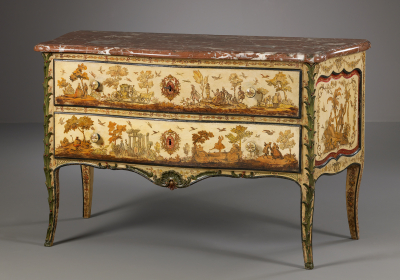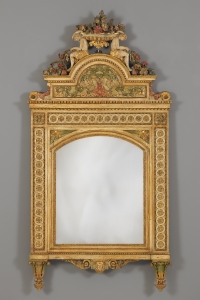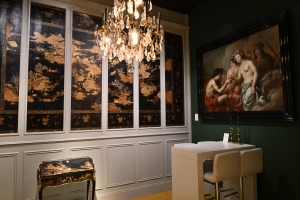Provencal Louis XV Lacca Povera Commode
Provencal Louis XV Lacca Povera Commode
A commode with two drawers and slightly undulating panels on three sides. The elegantly curving S-shaped side stiles that segue into the legs are decorated with sculptured, green-lacquered palm fronds with small red berries. Between these, below the drawers, the legs are decorated with an undulating skirt, itself centrally decorated with a green-lacquered shell motif. The sides both feature a slightly raised cartouche surrounded by a slightly recessed, red-lacquered band with gold decoration. All of the commode’s edges are bordered with a green, slightly recessed band that accentuates the commode’s elegant shapes. The Rouge Royale marble leaf follows the contours of the commode.
The drawers and cartouches on the sides are decorated with polychrome scenes of gallant figures in lovely landscapes with trees and birds. Elegant bands and draperies featuring bows, fruits, flowers and branches have been applied around the scenes in the cartouches and around the drawers, as well as on the side stiles, legs, and skirt. The commode is further decorated with individual flowers, birds, trelliswork, bands of green branches with red berries, and stylised ornaments.
This cream-coloured commode is a rare example of Lacca Povera furniture from the Provence, and was crafted around 1735-1740.
This technique is known as arte povera or Lacca Povera, and originated in Venice. Lacca Povera was an imitation of Oriental lacquerwork that flourished in this city. Cut-out and coloured-in prints were glued onto painted furniture, after which the whole was lacquered, resulting in a more affordable alternative for Eastern lacquerwork furniture, which was far more expensive at the time.
Although the term Lacca Povera, or “poor lacquer”, might seem to imply that this was cheap furniture, this is not the case: these items were intended for the aristocracy, who placed in in their palaces. It is no accident that Lacca Povera coincided with a rise in popularity among ladies of decoupage, the art of making cutouts of prints. This pastime, which was especially in fashion at court, inspired German and Italian printmakers to specialise in prints meant to be cut into pieces. The November 1727 edition of Mercure de France even advertised such prints with gallant scenes on white backgrounds, extolling their suitability for decoupage. Ladies in the eighteenth century undoubtedly decorated fire screens and small objects such as boxes, toiletry sets and serving platters; larger pieces such as commodes and secrétaires, however, were primarily decorated by experienced craftsmen in Venice, Piedmont and the Provence. Such items were ordered by the nobility, who proudly displayed them in their mansions.
The unidentified prints are either by the hand of the Remondinis, from Bassano, or Martin Engelbrecht, from Nuremberg. Around 1735, prints by the latter were reprinted in Paris by Daumont, Marchand d’estampes. In 1737, Jaques Langlois took out an advertisement in the December edition of the Mercure de France. announcing that he had the most splendid prints from Germany, as well as furniture that had been decorated using the Lacca Povera method. Exactly which items of furniture Langlois was advertising is unknown, however.
The cream-coloured background on which the cut-out prints have been glued is found on other items of French furniture, as well. Compare, for instance, a French commode auctioned at Sotheby’s in London on 6 December 2006, lot 49. However, in his authoritative work on Venetian lacquerwork, Saul Levy uses a white item of furniture to emphasise the similarities with French Lacca Povera pieces.
Literature:
Daniëlle O. Kisluk-Grosheide,"Cutting up Berchems, Watteaus, and Audrans": A "Lacca Povera" Secretary at the Metropolitan Museum of Art”, Metropolitan Museum Journal, Vol. 31, (1996), pp. 81-97.
Saul Levy, Laques vénitiennes du dix-huitieme siècle, Société française du livre, 1968. Zie met name deel I afb. 152.
Edith Mannoni, Mobilier Provençal, Parijs 1995, met name p. 29,30,38.
Sophie Reyssat, “Polychromie à l’Italienne”, Gazette Drout no 3, 25 januari 2008.
- Provenance
- Masi Gallery, Beaulieu-sur-Mère
Private collection, France
Private collection, Germany - Period
- ca. 1735
- Material
- walnut and oak core with cream-coloured lacquer, covered with lacquered cut-out and coloured-in prints, Rouge Royal marble top
- Dimensions
- 90 x 144 x 70 cm
Global shipping available









